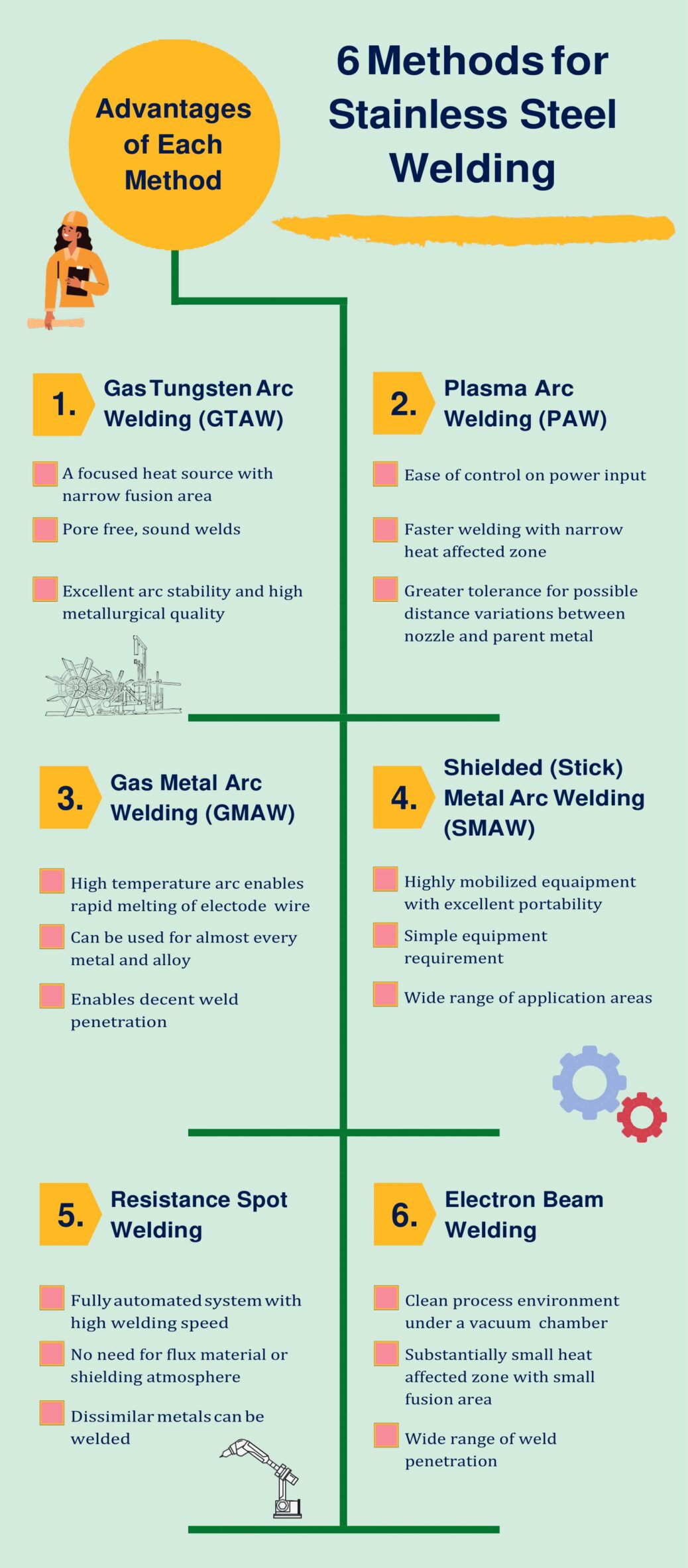The High-popularity of stainless steel in the engineering world is irrefutable for most production/maintenance applications. When failure mechanisms of the metals are inspected, one can easily mention the detrimental effects of corrosion failures. Hence, one of the most desired corrosion prevention techniques can be thought as the preference of the stainless steels for the target products. The importance of stainless steel is well-known for most engineering enthusiasts; however, joining techniques of stainless steel is not as much popular as stainless steel. One of the trickiest parts of the production stage of desired products is believed as the assembly process. Stainless steel performs high strength properties, so the deformation processes of the stainless steels can be challenging. However, stainless steel welding may become the solution for most of the assembly processes, which couldn’t accomplish the desired shape of the products by using plastic shaping methods. Stainless steel welding allows producers to create complex-shaped products. Moreover, stainless steel welding can be used for particular sections of the target products. For example, if the vendor demands only some certain parts made of stainless steel, stainless steel welding can be used for combining two or more different alloys in the same product.
The superior features of the stainless steels generated a huge utilization area for themselves, so stainless steel welding became a necessity for most of the engineering applications where the aim is to prevent the dangers of corrosion attacks. Stainless steel welding has some distinctive properties, but the methods used for stainless steel welding are very similar to those of ordinary carbon steels. The processes for stainless steel welding can be elaborated for further understanding; however, the listing of the numerous welding methods is not practical for a piece of solid knowledge. Hence, a listing of the six methods of stainless steel welding is way helpful for enthusiasts.
1. Gas Tungsten Arc Welding (GTAW)
Gas tungsten arc welding is a common process for stainless steel welding applications. This process is also known as tungsten inert gas (TIG) welding or wolfram inert gas welding. The required energy for melting the workpiece is generated by creating an arc between the tungsten electrode and parent metal. While generating the arc, inert or reducing atmospheres are chosen; this stems from the desire to prevent unwanted compounds during the welding process. Stainless steel welding has its requirements, even if the gas tungsten arc welding method is a common process for most alloy steels. Fundamentally, the polarity of the electrodes and the type of the current (direct or alternating) may affect the width and the depth of the weld seam. Therefore, stainless steel welding applications are conducted by using direct current electrode negative (DCEN) or direct current straight polarity (DCSP) options. Under these circumstances, the electrons strike the workpiece where deeper penetration is ensured. The tungsten electrode loses a small amount of material from its own during the arc is working. The stability of the arc during the welding operation is a crucial parameter for the proper progress of the process. Here, providing an inert atmosphere may be beneficial for an increment of the welding quality. When an inert gas atmosphere is ensured, the stability of the generated arc enhances. The type of shielding gases may depend on the parent metal. Usually, mixtures of argon, helium, and hydrogen are preferred. However, preference of the shielding gas mixture is also essential for stainless steel welding applications. During stainless steel welding, argon-hydrogen, argon-nitrogen, and argon-helium-hydrogen mixtures are used in specific amounts. The improper selection of the shielding gas type may cause in the loss of alloying elements. Moreover, the loss of alloying elements may hinder the corrosion resistance properties of the stainless steel. Hence, the selection of the accurate atmosphere directly affects the quality of the stainless steel welding. The below figure represents the gas tungsten arc welding method for stainless steel welding applications.
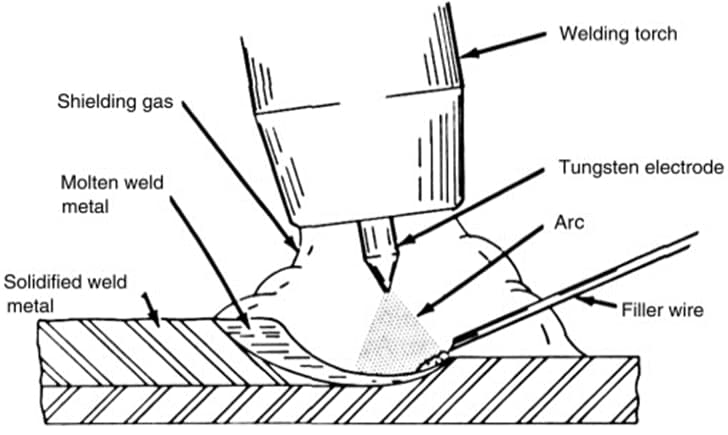
2. Plasma Arc Welding (PAW)
Plasma arc welding is very similar to gas tungsten arc welding in the manner of operation. However, the application of the arc plasma is a bit different from the GTAW applications. In plasma arc welding, the arc plasma is applied from a nozzle that constrains the arc’s spread. Thus, the process can yield an arc with excessive energy. The arc of the process is narrower than the common arc welding operations, so a wider stream of shielding atmosphere may be beneficial for stainless steel welding operations. The mixtures of the shielding gasses are similar to those of GTAW applications for stainless steel welding processes. The plasma arc welding process has some advantages over the gas tungsten arc welding method. Especially in stainless steel welding operations, a controlled plasma arc allows better control of the input energy. Since the amount of alloying elements are high for stainless steel, heat affected zone can be a problem for stainless steel welding operations. Narrower arc of the plasma arc welding decreases the size of the possible heat-affected zone. The below figure represents the plasma arc welding operations for stainless steel welding.
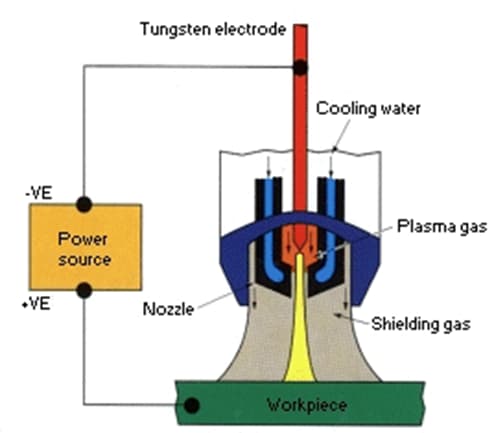
3. Gas Metal Arc Welding (GMAW)
The gas metal arc welding process, also known as metal inert gas welding, is very similar to GMAW and PAW processes in principle. Here an arc is produced between the electrode and parent metal. However, this method differs from the GMAW and PAW because of the utilization of a consumable electrode. Here, a high current density is maintained on the consumable wire electrode. Welding mode for stainless steel welding operations can be selected as direct current electrode positive (DCEP) or direct current reverse polarity (DCRP).
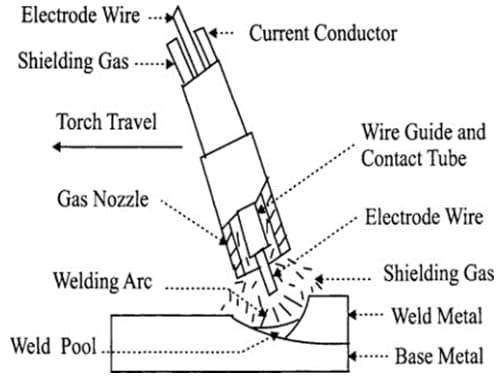
4. Shielded (Stick) Metal Arc Welding (SMAW)
Although the SMAW technique is a very old welding method, it is still common for most of welding applications because of its simplicity. Hence, the SMAW technique is preferred for stainless steel welding operations. The electrode of the method contains a core metal that is covered with flux material. Flux material hinders the formation of undesirable compounds, which can be harmful to stainless steel welding operations. In the SMAW process, formed slags can be easily removed. Rutile or lime electrodes are used for the operation.
5. Resistance Spot Welding
Resistance spot welding is mostly used for joining stainless steel sheets. Melting of the parent metals is ensured by applying an electrical current through the workpieces. Opposite currents generate excessive heat between the parent metals, which causes a fusion at the boundaries. Due to its simplicity and quickness, resistance spot welding is preferred for stainless steel welding applications. The below figure shows the resistance spot welding.
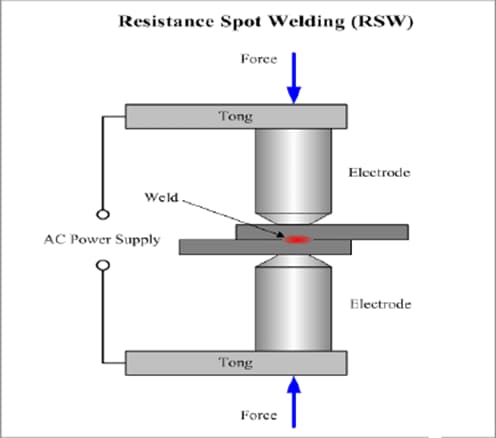
6. Electron Beam Welding
The electron beam welding process strikes electrons through the parent metal where high energy occurs. Thus, the melting of the workpiece is ensured by the collisions of the electrons. Deep and thin weld seams can be generated by using electron beam welding. Hence, susceptibility for the heat-affected zone is minimized, which is advantageous for stainless steel welding. The electron beam process for stainless steel welding applications is presented below.
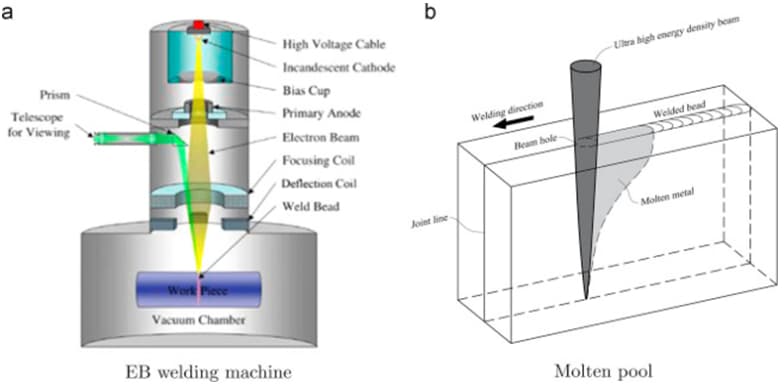
Other article that may interest: What You Should Know About Structural Steel Fabrication
References
- Cunat, P. (2007). The welding of stainless steel [Ebook]. Retrieved from https://www.worldstainless.org/Files/issf/non-image-files/PDF/Euro_Inox/BrochureWeldability_EN.pdf
- Antonini, J.M. (2014). Comprehensive Materials Processing || Health Effects Associated with Welding. , (), 49–70. doi:10.1016/B978-0-08-096532-1.00807-4

